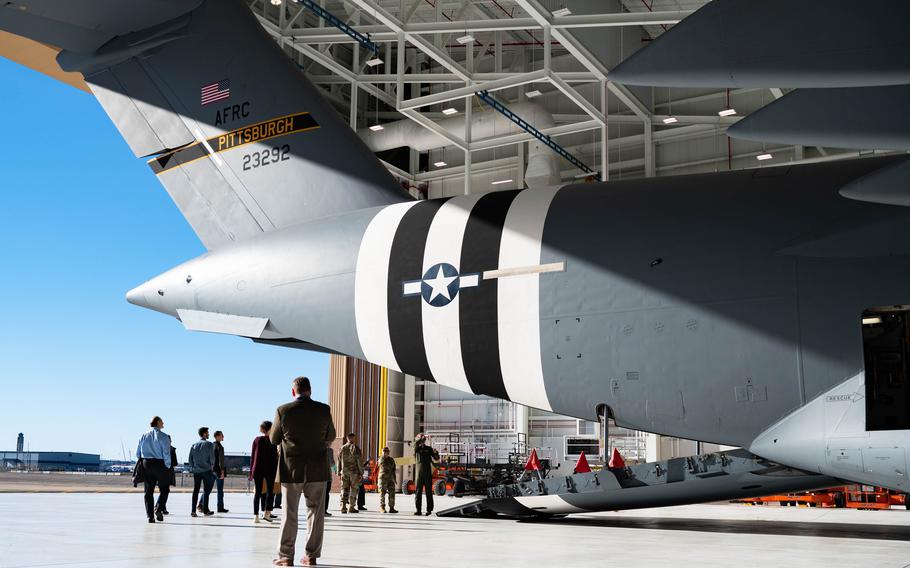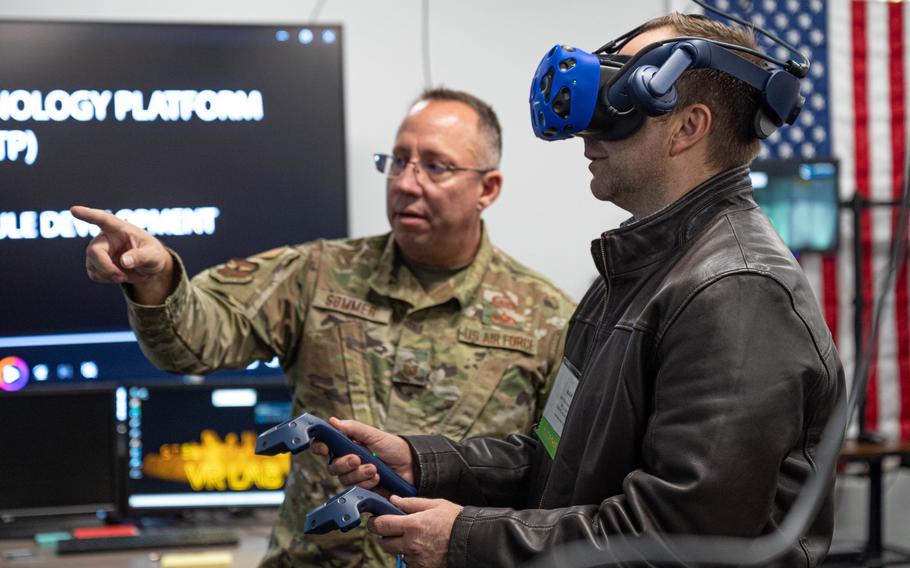
The 911th Airlift Wing welcomed nearly 50 individuals from the Pittsburgh Technology Council, businesses and state legislative offices to showcase its capabilities as a mission ready reserve wing. (911th Airlift Wing/Facebook)
(Tribune News Service) — Seconds after Jan Berkow took control of the C-17, one of the largest cargo planes in the Air Force fleet was veering sideways through the Pittsburgh skyline.
Suddenly sirens were blaring.
“You’re going past 37 degrees,” Lt. Col. Scott Cook calmly explained, before autopilot kicked in to steady the horizon.
Fortunately for the half dozen tech workers on board, the flight was only a simulation, carried out at the the Air Force Reserve Command’s 911th Airlift Wing outside Pittsburgh International Airport.
The base last week hosted Berkow, a University of Pittsburgh program manager, along with dozens of tech companies from the region who are looking to collaborate and potentially land contracts with the Department of Defense. For the base, the visit was a way to increase visibility. For the companies, a chance to refine their pitch.
The visit was organized by the Pittsburgh Technology Council and began with a briefing from Col. Bryan Bailey.
“On any given day, we have aircraft and airmen from this base all over the world,” said Bailey, whose missions as a C-17 pilot have brought him to 58 countries and all seven continents.
The base commander kept his remarks brief so he could get back to work preparing his airmen for a potential response to the growing Israel-Hamas war.
“We are probably going to be real busy real soon,” he said.
New tech addressing preventable deaths
In late October, the Air Force increased fighter presence in the Middle East to deter a wider conflict. Bailey said the U.S. has doubled its global airlift capacity over the last three weeks, with most of its efforts focused on the U.S. Central Command area of responsibility.
Several reserve members said the potential mobilization doesn’t feel out of the ordinary: They train to be mission ready at all times.
Others were in the region just two years ago.
Addam Kanish remembers evacuating hundreds of Afghani citizens from Kabul after the Taliban takeover. A former Air Force member who now works as a full-time nurse in the Pittsburgh region, Kanish had been to Afghanistan before. But the evacuations felt different, he said. For one, it was only him and one other medic on the plane.
“People were passing out. You really can’t do much. They give you a backpack of simple stuff,” he said.

The 911th Airlift Wing welcomed nearly 50 individuals from the Pittsburgh Technology Council, businesses and state legislative offices to showcase its capabilities as a mission ready reserve wing. (911th Airlift Wing/Facebook)
Even straightforward matters, like getting 400 people to sit along a tethered rope, proved difficult, as neither party spoke the other’s language.
Kanish remembers waiting for hours in sweltering heat for the cargo plane to take off.
Those might have been inevitable aspects of an urgent humanitarian mission. But to observers like Berkow, they appear as problems the broader community could help solve.
“A lot of the technologies we’re looking at are about preventable deaths,” said Berkow, who leads commercialization efforts at the University’s Center for Military Medicine Research.
Berkow was as charmed by the simulation cockpit as he was by the station’s machining laboratory, which can produce human-like skin and 3D-printed trachea.
Not all the development is quite as flashy. One of the lab’s big wins was a plastic tub for human excrement. The 3D printed version saved the Air Force $10,000 per unit, Master Sgt. Michael Howard said.
As he showed off various replacement parts for the station’s aging C-17 fleet, companies called out questions about the manufacturing process. Could a plane door be molded versus machined? How open source were its design specifications?
For Igor Stamenkovic, vice president of Eaton Corp.’s electronics division, the wheels were starting to spin.
A focus on innovation
Eaton has a major corporate office in Moon, just one town over from the base. It supplies some of the station’s power equipment and designs parts for planes like the C-17. Some of its employees even serve as reservists. But Stamenkovic had never ventured to visit.
He was the first to climb into the cockpit of the simulated C-17.
“Can you simulate landing in the river?” he asked.
“Yep. We could pull a Sully,” instructor Cook replied.
The model cockpit is suspended by massive 10-foot levers, giving it a realistic range of motion. It can shake to simulate turbulence or a sudden engine failure. Hours logged navigating the wraparound virtual airspace count as real flight hours, Cook said. And they can be more stressful than the real thing.
“We walk out of here sweating,” he said.
The base is piloting other virtual training programs too. In more consumer-grade virtual reality headsets, reservists can learn the fundamentals of aircraft control. Instructors join trainees in realistic VR renderings of actual cockpits, pointing out levers and warning lights without the expense of an in-person session.
A more surprising use for the headsets is mental health.
Reservists can do trauma simulations to prepare for graphic situations they might encounter in the real world. The base also sees the technology as a potential tool for suicide prevention.
“We do get some pushback from our older gentlemen who won’t sit in this room. But our new guys are eating it up,” said Master Sgt. Peter Sommer.
Pittsburgh Technology Council has arranged several meetings with Department of Defense agencies since launching a defense-based coalition in December. At least one contract, for Gecko Robotics, has come directly from that work.
Future partnerships would demonstrate DOD’s expanded willingness to partner with startups and less-proven companies.
It’s not entirely clear that they have the budget to do so.
“Funding can be a long, drawn out process,” said Jacob Schurer, a manager at the software development firm Rewynder, which is interested in potential DOD contracts.
Officials said companies interested in pitching should reach out to AFWERX, an offshoot of the Air Force Research Laboratory that focuses on innovation and has offices in Pittsburgh.
Unlike the Air Force’s small business innovation research program, which solicits targeted pitches for prescribed problems, officials said AFWERX is open to a broad swath of ideas.
(c)2023 the Pittsburgh Post-Gazette
Visit the Pittsburgh Post-Gazette at www.post-gazette.com
Distributed by Tribune Content Agency, LLC.